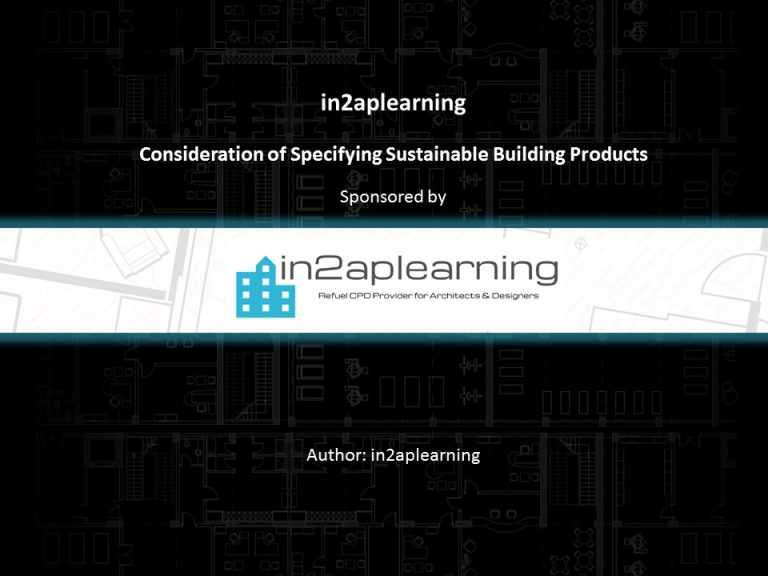What Are The Architectural Considerations For Creating Sustainable Workplaces?

Sustainability is a significant factor in modern architectural design. Designing spaces for people to work, live, and play in an environmentally friendly way is a responsibility that can't be ignored. For architects and designers, it's essential to consider sustainable materials and products when specifying building products. Here are some of the most important considerations when it comes to specifying sustainable architectural building products.
1. Durability
Durability is an important factor when it comes to specifying sustainable building products. When materials don't last, they end up being replaced more often, which ultimately contributes to waste. Choosing materials that are both durable and recyclable is incredibly important for the future of sustainable architecture.
2. Recyclability
The ability to recycle materials is a major consideration when it comes to sustainable design. Materials that can be easily repurposed or recycled help reduce waste and promote a circular economy. In addition, recycling materials significantly reduces the environmental impact of construction.
3. Carbon Footprint
The carbon footprint of a material refers to the amount of carbon dioxide released into the atmosphere during its production and transportation. Specifying products with a low carbon footprint is incredibly important when it comes to sustainable design. Materials that are locally sourced and require minimal transportation have a significantly lower carbon footprint and are generally better for the environment.
4. Water Conservation
Water conservation is an essential consideration when it comes to sustainable building products. Specifying products that require minimal water use or those that can capture and repurpose rainwater can significantly reduce water consumption and lower the environmental impact of construction.
5. Health and Safety
Sustainability encompasses more than just the environmental impact of building products. It's important to consider the health and safety of the people who will be using the space when specifying materials. Products with low toxicity or those made from natural materials are generally better for the health and well-being of building occupants.
6. Energy Efficiency
Specifying energy-efficient building products can significantly reduce the environmental impact of construction. Materials that are designed to minimize energy consumption or generate renewable energy can significantly reduce a building's carbon footprint.
7. Life Cycle Cost
The life cycle cost of a building product is the total cost of ownership over the course of its lifetime. Specifying materials with a high life cycle cost can ultimately save money over time by avoiding excessive replacements or maintenance costs.
8. Functionality and Aesthetic Appeal
Functionality and aesthetic appeal are important considerations when specifying architectural building products. The products must meet the functional needs of the building while also being visually appealing. Sustainability doesn't have to come at the cost of design or functionality.
FAQ
What is sustainable architecture?
Sustainable architecture is the practice of designing buildings with environmental sustainability in mind. It involves using materials and techniques that minimize the environmental impact of construction and promote a circular economy.
Why is sustainability important in architecture?
Sustainability is important in architecture because buildings account for a significant portion of global greenhouse gas emissions. Incorporating sustainable practices into building design can help mitigate the negative environmental impact of construction.
What are the benefits of sustainable architecture?
The benefits of sustainable architecture include reduced energy consumption, lower greenhouse gas emissions, reduced waste, improved indoor air quality, and cost savings over the lifetime of the building.
What are some sustainable building materials?
Sustainable building materials include recycled materials, bamboo, cork, natural wood, and sustainable concrete.
What is a circular economy?
A circular economy is an economic system that aims to minimize waste and promote the continuous use of resources. In a circular economy, products and materials are kept in use for as long as possible, and waste is minimized through recycling and repurposing.
What is a carbon footprint?
A carbon footprint is the amount of carbon dioxide and other greenhouse gases that are released into the atmosphere as a result of human activities.
What is the life cycle cost of a building product?
The life cycle cost of a building product is the total cost of owning and maintaining the product over its lifetime. It includes the initial cost of purchasing and installing the product, as well as maintenance and replacement costs.
What is energy-efficient design?
Energy-efficient design refers to the practice of designing buildings with the goal of minimizing energy consumption and maximizing energy efficiency. It involves using materials and techniques that reduce the amount of energy required to heat, cool, and light a space.
What are some energy-efficient building products?
Energy-efficient building products include insulated windows, Energy Star-rated appliances, LED lighting, and solar panels.
In conclusion, sustainable architecture is crucial for the future of our planet. When specifying architectural building products, it's important to consider durability, recyclability, water conservation, energy efficiency, functionality, and aesthetic appeal. By prioritizing these considerations, architects and designers can promote sustainability and help mitigate the negative environmental impact of construction.




Post a Comment for "What Are The Architectural Considerations For Creating Sustainable Workplaces?"